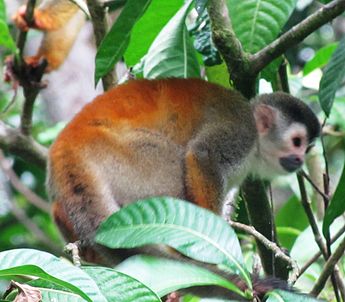Titi Monkey or Squirrel Monkey

Squirrel Monkey or Marmoset Saimiri oerstedii
The Titi or squirrel monkey is the smallest monkey in Costa Rica (measuring 40 cm) and is also the most endangered. Currently there are two subspecies, the first and most endangered is found in the area of Parrita, Quepos and Potrero Grande de Buenos Aires, the other subspecies is found in the south of the country mainly in the Osa Peninsula. It is distributed from sea level to 500 mt above sea level.
Behavior of the Titi Monkey
They usually travel in groups of between 10 and 60; these include several adult males, a smaller number of females and even fewer small ones.
The mating period is in September and during February and March, the small babies can be observed on their mothers’ backs. Because they are so small, they are easy prey for snakes, birds and cats.
Characteristics of the Titi monkey
It is small, weighing less than 1 kg. Its fur is short and yellowish olive colored, its back and limbs are orange, its head crest, snout and eyes are black, its cheeks and nose are skin colored. It moves quickly among the branches producing a high-pitched whistling sound. Unlike other monkeys, the squirrel does not have a prehensile tail to help it hold on to trees when hunting.
Currently they can only be found in the Osa Peninsula, in the Manuel Antonio National Park in Quepos.
Titi Monkey Diet
Like most primates, the squirrel is omnivorous, its diet includes roots, grains, fruits, insects, worms, small frogs and lizards. The marmoset monkey spends a great deal of time moving around and foraging in the forest.
M. Barrantes – Sensorial Sunsets
Sources
https://es.wikipedia.org/wiki/Saimiri_oerstedii




